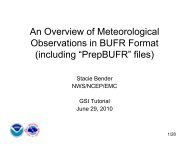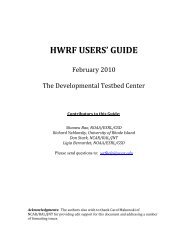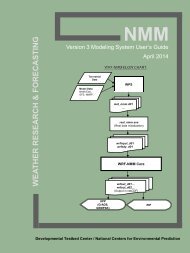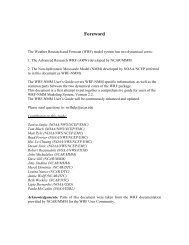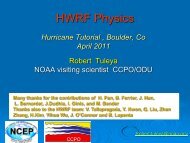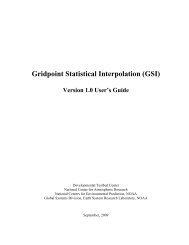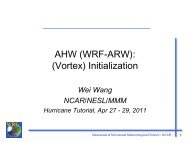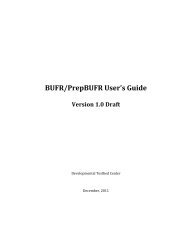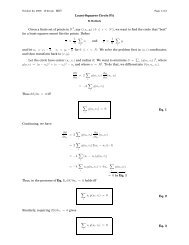corresponding source grid point. Given this array, the data are written to a file, row-byrow,beginning at the bottom, or southern-most, row. For example, in the figure above,the elements of the n × m array would be written in the order x 11 , x 12 , ..., x 1m , x 21 , ..., x 2m ,..., x n1 , ..., x nm . When written to the file, every element is stored as a 1-, 2-, 3-, or 4-byteinteger in big-endian byte order (i.e., for the 4-byte integer ABCD, byte A is stored at thelowest address and byte D at the highest), although little-endian files may be used bysetting endian=little in the "index" file for the data set. Every element in a file mustuse the same number of bytes for its storage, and, of course, it is advantageous to use thefewest number of bytes needed to represent the complete range of values in the array.When writing the binary data to a file, no header, record marker, or additional bytesshould be written. For example, a 2-byte 1000 × 1000 array should result in a file whosesize is exactly 2,000,000 bytes. Since Fortran unformatted writes add record markers, it isnot possible to write a geogrid binary-formatted file directly from Fortran; instead, it isrecommended that the C routines in read_geogrid.c and write_geogrid.c (in thegeogrid/src directory) be called when writing data, either from C or Fortran code.Similar in format to a field of dominant categories is the case of a field of continuous, orreal, values. Like dominant-category fields, single-level continuous fields are firstorganized as a regular 2-d array, then written, row-by-row, to a binary file. However,because a continuous field may contain non-integral or negative values, the storagerepresentation of each element within the file is slightly more complex. All elements inthe array must first be converted to integral values. This is done by first scaling allelements by a constant, chosen to maintain the required precision, and then removing anyremaining fractional part through rounding. For example, if three decimal places ofprecision are required, the value -2.71828 would need to be divided by 0.001 androunded to -2718. Following conversion of all array elements to integral values, if anynegative values are found in the array, a second conversion must be applied: if elementsare stored using 1 byte each, then 2 8 is added to each negative element; for storage using2 bytes, 2 16 is added to each negative element; for storage using 3 bytes, 2 24 is added toeach negative element; and for storage using 4 bytes, a value of 2 32 is added to eachnegative element. It is important to note that no conversion is applied to positiveelements. Finally, the resulting positive, integral array is written as in the case of adominant-category field.Multi-level continuous fields are handled much the same as single-level continuousfields. For an n × m × r array, conversion to a positive, integral field is first performed asdescribed above. Then, each n × m sub-array is written contiguously to the binary file asbefore, beginning with the smallest r-index. Categorical fields that are given as fractionalfields for each possible category can be thought of as multi-level continuous fields, whereeach level k, 1 ≤ k ≤ r, is the fractional field for category k.When writing a field to a file in the geogrid binary format, the user should adhere to thenaming convention used by the geogrid program, which expects data files to have namesof the form xstart-xend.ystart-yend, where xstart, xend, ystart, and yend are five-digitpositive integers specifying, respectively, the starting x-index of the array contained in<strong>WRF</strong>-NMM V3: User’s Guide 3-29
the file, the ending x-index of the array, the starting y-index of the array, and the endingy-index of the array; here, indexing begins at 1, rather than 0. So, for example, an 800 ×1200 array (i.e., 800 rows and 1200 columns) might be named 00001-01200.00001-00800.When a data set is given in several pieces, each of the pieces may be formed as a regularrectangular array, and each array may be written to a separate file. In this case, therelative locations of the arrays are determined by the range of x- and y-indices in the filenames for each of the arrays. It is important to note, however, that every tile in a data setmust have the same x- and y-dimensions, and that tiles of data within a data set must notoverlap; furthermore, all tiles must start and end on multiples of the index ranges. Forexample, the global 30-second USGS topography data set is divided into arrays ofdimension 1200 × 1200, with each array containing a 10-degree × 10-degree piece of thedata set; the file whose south-west corner is located at (90S, 180W) is named 00001-01200.00001-01200, and the file whose north-east corner is located at (90N, 180E) isnamed 42001-43200.20401-21600.If a data set is to be split into multiple tiles, and the number of grid points in, say, the x-direction is not evenly divided by the number of tiles in the x-direction, then the lastcolumn of tiles must be padded with a flag value (specified in the index file using themissing_value keyword) so that all tiles have the same dimensions. For example, if adata set has 2456 points in the x-direction, and three tiles in the x-direction will be used,the range of x-coordinates of the tiles might be 1 – 820, 821 – 1640, and 1641 – 2460,with columns 2457 through 2460 being filled with a flag value.Clearly, since the starting and ending indices must have five digits, a field cannot havemore than 99999 data points in either of the x- or y-directions. In case a field has morethan 99999 data points in either dimension, the user can simply split the data set intoseveral smaller data sets which will be identified separately to geogrid. For example, avery large global data set may be split into data sets for the Eastern and Westernhemispheres.Besides the binary data files, geogrid requires one extra metadata file per data set. Thismetadata file is always named 'index', and thus, two data sets cannot reside in the samedirectory. Essentially, this metadata file is the first file that geogrid looks for whenprocessing a data set, and the contents of the file provide geogrid with all of theinformation necessary for constructing names of possible data files. The contents of anexample index file are given below.type = continuoussigned = yesprojection = regular_lldx = 0.00833333dy = 0.00833333known_x = 1.0known_y = 1.0known_lat = -89.99583known_lon = -179.99583wordsize = 2<strong>WRF</strong>-NMM V3: User’s Guide 3-30
- Page 1 and 2:
ForewordUser's Guide for the NMM Co
- Page 3 and 4:
• WPP Directory Structure 7-3•
- Page 5 and 6:
The WRF modeling system software is
- Page 7 and 8:
WRF-NMM FLOW CHARTTerrestrialDataMo
- Page 9 and 10:
Vendor Hardware OS CompilerCray X1
- Page 11 and 12:
If all of these executables are def
- Page 13 and 14:
Once the tar file is obtained, gunz
- Page 15 and 16:
HWRF is set, then (3) will be autom
- Page 17 and 18:
In addition to these three links, a
- Page 19 and 20:
• Real-data simulations• Non-hy
- Page 21 and 22:
k. Morrison double-moment scheme (1
- Page 23 and 24:
g. GFDL surface layer (88): (This s
- Page 25 and 26:
Other physics optionsa. gwd_opt: Gr
- Page 27 and 28:
to the convergence of meridians app
- Page 29 and 30:
Variable NamesValue(Example)Descrip
- Page 31 and 32:
Variable NamesValue(Example)Descrip
- Page 33 and 34:
Variable NamesValue(Example)Descrip
- Page 35 and 36:
Variable NamesValue(Example)Descrip
- Page 37 and 38:
Variable NamesValue(Example)Descrip
- Page 39 and 40:
mpirun.lsf wrf.exeand for interacti
- Page 41 and 42:
The boundary conditions for the nes
- Page 43 and 44:
Examples:1. One nest and one level
- Page 45 and 46:
ottom_top_stag = 28 ;soil_layers_st
- Page 47 and 48:
float HLENSW(Time, south_north, wes
- Page 49 and 50:
float HBOTS(Time, south_north, west
- Page 51 and 52:
operational mesoscale Eta model. J.
- Page 53 and 54:
Mlawer, E. J., S. J. Taubman, P. D.
- Page 55 and 56:
NCEP WRF Postprocessor (WPP)WPP Int
- Page 57 and 58:
./configureYou will be given a list
- Page 59 and 60:
equested output field. If the pre-r
- Page 61 and 62:
RAINCV SNOW HBOTRAINNCVSNOWCNote: F
- Page 63 and 64:
Running WPPFour scripts for running
- Page 65 and 66:
i. As the grid id of a pre-defined
- Page 67 and 68:
The GrADS package is available from
- Page 69 and 70:
Height on pressure surface HEIGHT O
- Page 71 and 72:
MELTPrecipitation type (4 types) -
- Page 73 and 74:
Press at tropopause PRESS AT TROPOP
- Page 75 and 76:
RIP4RIP IntroductionRIP (which stan
- Page 77 and 78:
A successful compilation will resul
- Page 79 and 80:
iinterp = 0v v v v vH V H V h h h h
- Page 81 and 82:
espectively, of the centered domain
- Page 83 and 84:
This can be either 'h' (for hours),
- Page 85:
eal variable expect values that are
- Page 88 and 89: of all the requested trajectories a
- Page 90 and 91: Creating Vis5D Dataset with RIPVis5
- Page 92 and 93: User’s Guide for the NMM Core of
- Page 94 and 95: Configuration: The configure script
- Page 96 and 97: This program reads the contents of
- Page 98 and 99: Period - Describes communications f
- Page 100 and 101: fine grid), f (forcing, how the lat
- Page 102 and 103: # halo HALO_NMM_K dyn_nmm8:q2;24:t
- Page 104 and 105: (http://www.mmm.ucar.edu/wrf/WG2/Ti
- Page 106 and 107: User's Guide for the NMM Core of th
- Page 108 and 109: 2. Make sure the files listed below
- Page 110 and 111: User's Guide for the NMM Core of th
- Page 112 and 113: Program geogridThe purpose of geogr
- Page 114 and 115: 1. Define a model coarse domain and
- Page 116 and 117: to GEOGRID.TBL in the geogrid direc
- Page 118 and 119: the GRIB data were downloaded to th
- Page 120 and 121: By this point, there is generally n
- Page 122 and 123: two nests are defined to have the s
- Page 124 and 125: Note: For the WRF-NMM the variables
- Page 126 and 127: simulations may use a constant SST
- Page 128 and 129: entire simulation domain, and data
- Page 130 and 131: that lists the variables and attrib
- Page 132 and 133: http://www.ecmwf.int/products/data/
- Page 134 and 135: intermediate formats (metgrid/src/r
- Page 136 and 137: GRIB1| Level| From | To |Param| Typ
- Page 140 and 141: tile_x = 1200tile_y = 1200tile_z =
- Page 142 and 143: 1. PARENT_ID : A list of MAX_DOM in
- Page 144 and 145: V -DX- H| / |DY dx DY| / |H - DX- V
- Page 146 and 147: intermediate files if ungrib is to
- Page 148 and 149: the index and data tiles for the da
- Page 150 and 151: 1. PROJECTION : A character string
- Page 152 and 153: 25. SCALE_FACTOR : A real value tha
- Page 154 and 155: 10. INTERP_MASK : The name of the f
- Page 156 and 157: 1. four_pt : Four-point bi-linear i
- Page 158 and 159: 8. search : Breadth-first search in
- Page 160 and 161: 19 Mixed Tundra20 Barren TundraTabl
- Page 162 and 163: LU_INDEX:units = "category" ;LU_IND
- Page 164 and 165: netcdf met_em.d01.2009-01-05_12:00:
- Page 166: }:ISOILWATER = 14 ;:grid_id = 1 ;:p



